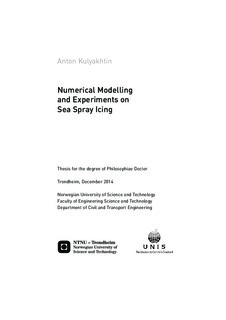Numerical Modelling and Experiments on Sea Spray Icing
Doctoral thesis

Åpne
Permanent lenke
http://hdl.handle.net/11250/277036Utgivelsesdato
2014Metadata
Vis full innførselSamlinger
Sammendrag
Oil and gas activities in the cold seas are endangered by icing. Icing may occur when
water spray or moisture is deposited on a vessel or offshore structure above sea level
and the air temperatures is below the freezing temperature of water. Ice accumulation
can block rescue equipment and doors, and clog ventilation systems, which may
increase the risk of explosion as result of volatile gas accumulation. Icing can be caused
by supercooled fog, freezing rain, falling snow and freezing sea spray. The freezing sea
spray caused 80 – 90% of all offshore icing incidents and is the focus of this study.
To take precautions against icing, it is important to understand the physics of icing and
to model it. The rate of ice accretion is mainly defined by the spray flux and heat
transfer, and both must be accurately predicted. Existing icing models, e.g., ICEMOD
and RIGICE04, simplify the structure, subdividing it into cylindrical and flat
components. In these models, airflow around a component is assumed to be unaffected
by other parts of the structure, and the heat transfer is approximated using empirical
relations. In reality, however, the airflow field is complex. Upwind components can
create wind shadow regions or regions of accelerated flow in front of downwind
components; this changes both the spray flux and the heat transfer, thus making
ICEMOD and RIGICE04 inadequate.
A research subject of this PhD study was the heat transfer and spray flow around a
structure in a real airflow. The full-scale measurements in the literature are limited and
it is expensive to perform them. Therefore, for a preliminary answer the question was
addressed using computational fluid dynamics (CFD), which is capable of predicting
the spray flow and heat transfer around a structure with any shape; however, the
accuracy of CFD is uncertain.
Existing models of sea spray icing, e.g., ICEMOD and RIGICE04, neglect heat flux into
the accreted ice and assume that air cooling is directly spent to freeze the water film on
the ice surface. This assumption is good for steady ice growth. However, it is also used
in modelling icing caused by periodic sea spray. This study proves numerically and
experimentally that the heat flux into the accreted ice generated by freezing must not be
neglected.
The main contributions of this work are as follows:
The study develops the marine icing model, MARICE, which uses CFD to
calculate spray flux and heat transfer, and models water film motion on any
arbitrary surface.
· The study shows that Reynolds-averaged Navier-Stokes (RANS) models should
be used with care in icing simulations: the collision efficiency is well predicted
upstream flow separation point by any RANS turbulence model; however, the
wake and separation of the flow is modelled poorly.
· The study develops and validates a new model of ice growth caused by periodic
sea spray, which accounts for the heat conduction inside the accreted ice.
Består av
Paper 1: Kulyakhtin A., Løset S., 2011. Sea spray icing: In-cloud evaporation. Semianalytical and numerical investigation. International Workshop on Atmospheric Icing (IWAIS2011), Chong-Chin, ChinaPaper 2: Kulyakhtin, A., Kollar, L, Løset, S., Farzaneh, M., 2012. Numerical simulation of 3D spray flow in a wind tunnel with application of O'Rourke's interaction algorithm and its validation. Proceedings of the 21st IAHR International Symposium on Ice (IAHR2012).
Paper 3: Kulyakhtin, A., Shipilova, O., Libby, B. and Løset, S., 2012. Full-scale 3D CFD simulation of spray impingement on a vessel produced by ship-wave interaction. Proceedings of the 21st IAHR International Symposium on Ice (IAHR2012).
Paper 4: Kulyakhtin A., Kulyakhtin S., Løset S. Measurements of Thermodynamic Properties of Ice Created by Frozen Sea Spray, 2013. The 23rd International Ocean and Polar Engineering Conference (ISOPE), Anchorage, USA, June 30 - July 5 2013.
Paper 5: Kulyakhtin, A., Shipilova, O. and Muskulus, M., 2014. Numerical simulation of droplet impingement and flow around a cylinder using RANS and LES models. Journal of Fluid and Structures, Vol. 48, pp. 280-294. http://dx.doi.org/10.1016/j.jfluidstructs.2014.03.007 The article in is reprinted with kind permission from Elsevier, www.sciencedirect.com
Paper 6: Kulyakhtin, A., Tsarau, A., 2014. A time-dependent model of marine icing with application of computational fluid dynamics, Journal of Cold Regions Science and Technology, Vol. 104-105, pp. 33-44. http://dx.doi.org/10.1016/j.coldregions.2014.05.001 The article in is reprinted with kind permission from Elsevier, www.sciencedirect.com
Paper 7: Kulyakhtin, A., Kulyakhtin, S. and Løset, S, 2014. The role of the ice heat conduction in the ice growth caused by periodic sea spray. Journal of Cold Regions Science and Technology (submitted).